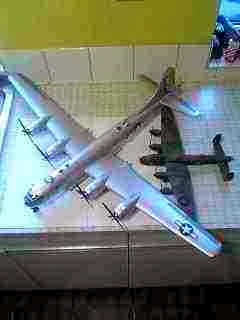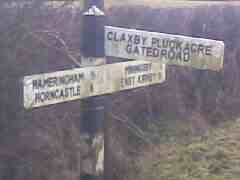At a few minutes to 6pm the villagers to the east of RAF Coningsby were finishing the last of their Christmas turkey after the 'first day back' at work in Jan '53. Rationing was easing, and a sign of that was the change in engine noise from the RAF field. Guy Gibson's Mosquitoes were becoming a memory, and even the big Lancasters had temporarily given way to a lend-lease of 87 planes of the B29 Superfortress type, half as large again as the Avro bombers. The noise of the one plane striving for height over the Witham plain sounded a booming thrum of space age warning, that only a nuclear bomber could conjure.

Lancaster Size v Superfortress
Indeed, the  Enola Gay B29 had only 8yrs before ended the
Enola Gay B29 had only 8yrs before ended the  war in Japan; WF533 was of similar vintage. All the newest Fortresses were on Guam and Okinawa, setting about North Korea, whilst these older machines filled in until the Canberra and Avro Vulcan became available. The early part of a flight in these massive 50ton warhorses was a strain for height and airspeed, to enable cooling of the big old engines. These had a history of catching fire. Burping carbs, mismatched
war in Japan; WF533 was of similar vintage. All the newest Fortresses were on Guam and Okinawa, setting about North Korea, whilst these older machines filled in until the Canberra and Avro Vulcan became available. The early part of a flight in these massive 50ton warhorses was a strain for height and airspeed, to enable cooling of the big old engines. These had a history of catching fire. Burping carbs, mismatched  metal heat expansion and impossible gasketing, combined with magnesium engine casings, had cost the life of the
metal heat expansion and impossible gasketing, combined with magnesium engine casings, had cost the life of the  test pilot, crew, and a score of Texan factory workers during a test flight crash in the war years.
test pilot, crew, and a score of Texan factory workers during a test flight crash in the war years.
As the Coningsby flight headed out for 4+ hours of training, light snow and a freezing thick fog moved in from the North sea, shrouding the near Full Moon. After 3 and a half hours of increasingly inclement weather, Flt. Lt. P Haddock at Coningsby ATC heard the radio crackle into life as one of the four Flt. Sgnts on board advised of approach. The fog was dense at ground level and the plane, using instruments, wasn't in line on the first attempt. Gunning the four engines it soared around, with it's navigation lights blinking, for a second try. ATC advised them to start their 5th auxilliary engine, textbook practice that would give much smoother control and turn the massive flaps and rudder into finger touch operation, boosting the power availiability to the four outboard engines.
Coming around on a second run, the plane was now too high, the pilot dicing with new found power, and an estimation of the depth of the fog height. Sgt. K J White listened to the engines - with their history a superfortress in prolonged slow flight was to be watched, and engines feathered and isolated at the first change in pitch or traces of fluids. He would later testify that no abnormalities were seen or heard. As the plane rose up at extra full throttle for the third time that night, it banked quickly off to the left this time, disappearing into the foggy night, the pilot trying to orientate himself fully to the landmarks and any village lights in the gloom below.
Aircrash
George Hill, the Miningsby village blacksmith looked up as the massive bomber bore down over his house. Tom Pennington, 16, of Miningsby Grange, heard a very poorly aircraft, the "one engine spitting like the Dickens, and another backfiring".
Mrs Ashton heard the "roar of a very low flying aircraft" and an ominous "thud". Tom had watched it come down in the 3rd field out, behind the Grange. The surrounding villagers heard the commotion. First eyewitnesses found the wreckage spread over a wide area and a steady fire at the front of the partially embedded fuselage. 2 airmen had made it out of the rear gunnery hatch, the tail section all but in one piece; 3 more made it out of a top hatch, their bloodied faces a garish mask in the glow of a aero fuel fire. Albert Ashton had brought a shovel and bravely dug earth to throw over the flames. His daughter ran a quarter mile to the farm with a telephone, bringing back Herbert Scotson, who brought an axe. A crewman could be heard shouting for help, but in the wreckage and night fog on a sloped field, it wasn't until he shouted "in the plane" that he could be found, buried beneath an engine. The size of a lorry, it had shielded him from the worst of the fire.

It took "some time" to get the engine away and ambulances were now arriving. The 5 walking wounded were taken to Mrs Ashton's cottage for warm drinks... (definitely not 1st Aid 2011!). The injured airman from beneath the engine, Flt. Lt. F G Read, navigation/plotter, had both legs crushed and a broken arm, but had been "chatting cheerfully" until released, when the poisoned blood suddenly circulated and he was rushed to Nocton Air hospital in a grave condition.
[ half a paracetomol is now known to combat this toxic shock.] Horncastle and Spilsby Fire crews had arrived, with Skegness and the Coningsby Crash Tender.
Inquest
Five other airmen were in the front section, and all were dead, including the 4 Flt Sgnts : E Matthews, 29 of Wales; G Tomblin 29 Coningsby; L F Lloyd 29 Suffolk; Robert Douglas Howes (newspaper: R D Hawes) 34 Hampshire, and Flt Lt. F A Rust 29 Bournemouth, and accidental death was recorded at the inquest, Tues 13th Jan 1953 by Dept. Coroner J C Walter esq. who commended the Great Gallantry of the farm workers rescue.
Talking with a local farmer, he related to me the disbelief of rescuers at the state of the cockpit area. With the impact (and perhaps heat from the fire), the pilots had all lost considerable stature. Apparently it's fairly common in high inertia  impact crashes.
By 1am the crash site had been searched and secured in the frost, fog, snow and darkness. In the first light of dawn, a glaring white cut and smashed branches lead investigators to their official conclusion that the plane had just been flying too low in the fog. Although the Wold is 80m to the NE of Coningsby at Claxby Pluckacre trig point (and 127m at the A158 road), the trees took minimum clearance to over 110m and 160m respectively. The undercarriage was also deployed and over 2m proud of the craft.
impact crashes.
By 1am the crash site had been searched and secured in the frost, fog, snow and darkness. In the first light of dawn, a glaring white cut and smashed branches lead investigators to their official conclusion that the plane had just been flying too low in the fog. Although the Wold is 80m to the NE of Coningsby at Claxby Pluckacre trig point (and 127m at the A158 road), the trees took minimum clearance to over 110m and 160m respectively. The undercarriage was also deployed and over 2m proud of the craft.
In hindsight one has to perhaps ask why the plane wasn't diverted on, if it's engines were sound, to Waddington's B29 station. Anywhere out of the deadly Fen fog (marsh gas), perhaps towards  Lincolnshire's City lights. Especially as 3 weeks previously RAF Marham lost WF570 14/12/52 in similar circumstances, bad weather compass/map landing with 4 fatalities. Three days after the Coningsby crash, the trifector, with
Lincolnshire's City lights. Especially as 3 weeks previously RAF Marham lost WF570 14/12/52 in similar circumstances, bad weather compass/map landing with 4 fatalities. Three days after the Coningsby crash, the trifector, with  WF502 and 10 crewmen killed at Marham. With the Korean war nearing it's end, one of the final raids lost 34 craft; 20 to the enemy fighters and flak, yet 14 planes to "other causes".
WF502 and 10 crewmen killed at Marham. With the Korean war nearing it's end, one of the final raids lost 34 craft; 20 to the enemy fighters and flak, yet 14 planes to "other causes".